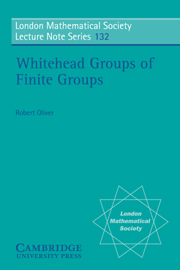Book contents
- Frontmatter
- Contents
- Introduction
- Part I General theory
- Chapter 1 Basic algebraic background
- Chapter 2 Structure theorems for K1 of orders
- Chapter 3 Continuous K2 and localization sequences
- Chapter 4 The congruence subgroup problem
- Chapter 5 First applications of the congruence subgroup problem
- Chapter 6 The integral p–adic logarithm
- Part II Group rings of p–groups
- Part III General finite groups
- References
- Index
Chapter 2 - Structure theorems for K1 of orders
Published online by Cambridge University Press: 17 December 2009
- Frontmatter
- Contents
- Introduction
- Part I General theory
- Chapter 1 Basic algebraic background
- Chapter 2 Structure theorems for K1 of orders
- Chapter 3 Continuous K2 and localization sequences
- Chapter 4 The congruence subgroup problem
- Chapter 5 First applications of the congruence subgroup problem
- Chapter 6 The integral p–adic logarithm
- Part II Group rings of p–groups
- Part III General finite groups
- References
- Index
Summary
This chapter presents some of the basic applications of the reduced norm and logarithm homomorphi sms to describe K1 (A) and K1(A), when A is a ℤ-order or ℤp -order in a semi simple ℚ- or Qp -algebra A. For example, K1- (A) is shown to be finitely generated whenever A is a ℤ-order; and is shown to be a product of a finite group with a finitely generated ℤp -module in the ℤp -order case. In both cases, the rank of K1(A) is determined. Also, SK1(A) is shown (for both ℤ- and ℤp -orders) to be the kernel of the “reduced norm” homomorphism from K1(A) to units in the center of A.
The results about reduced norms are dealt with in Section 2a. These include all of the results about ℤ-orders mentioned above, as well as some properties of ℤp-orders. Then, in Section 2b, p-adic logarithms are applied to show, for example, that for any ℤp-order A, E(A) is p-adically closed in GL(A) (i. e., that K1(A) is Hausdorff in the p-ad i c topo1ogy).
Applications of the reduced norm
For any field F, and any central simple F-algebra A, the reduced norm homomorphismnr.A/k:A* → F* F for A is defined as follows. Let E ⊇ F be any extension which splits A, and fix an isomorphism E⊗FA Mn Then for any a ∈ A*, set nrA/F(a) = detE((1⊗a)) ∈ E*. This is independent of the choice of : any two such isomorphisms differ by an inner automorphism of Mn (E) by the Skolem-Noe ther theorem (Theorem l.l(iv) above).
- Type
- Chapter
- Information
- Whitehead Groups of Finite Groups , pp. 40 - 62Publisher: Cambridge University PressPrint publication year: 1988



